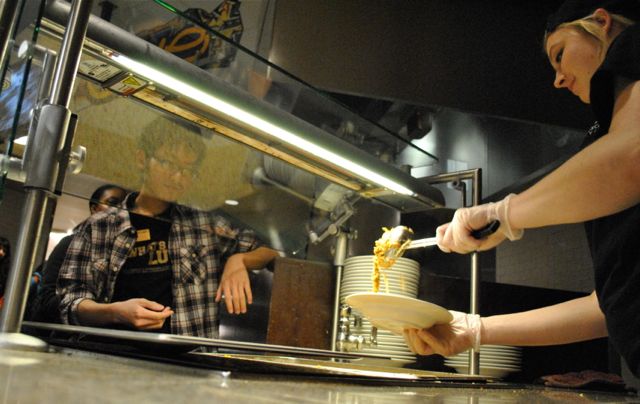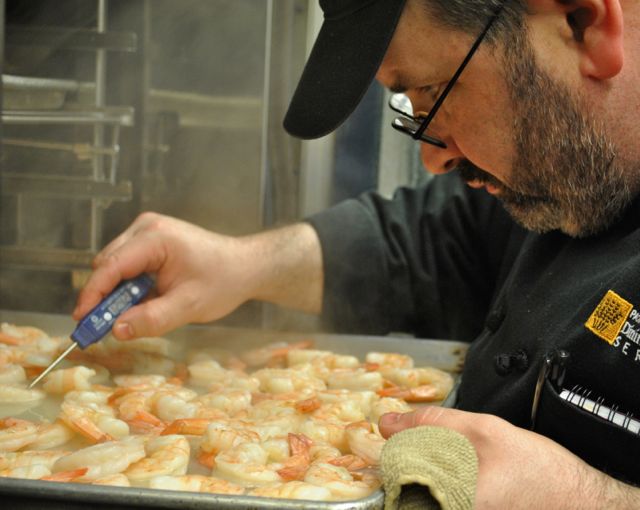
Food For Thought
Two decades ago Erick Swenson ’91 was a junior studying music at PLU. He’d eat dinner with fellow choir students at long industrial, cafeteria style tables that have since been replaced by smaller, more intimate tables and booths. Having grown up in a family where food was not very plentiful, he was considerably more impressed by the food than his peers.
“I can remember getting excited about the beef stroganoff and lasagna,” Swenson recalled. “I still have fond memories of grilled cheese sandwiches and tomato soup.”
Outside the dining hall though, Swenson, like other college students, ate on a budget.
“From what I remember [of] being a student living off campus, you’re living an awful lot off of what’s inexpensive,’ Swenson said. “I lived a lot off of Top Ramen. Rice is again one of those things. You can make a lot of it for not a lot of money.”

‘I’ll have the soup’
Rebecca Goulson ’15 admits that she doesn’t really know how to cook, but, as a sophomore who lives on campus and has a meal plan, she doesn’t need to.
Looking back, Swenson said had he known then what he knows now he would have mixed some beans in his diet.
Two years later, one year out of school, Swenson found himself back in the classroom, but this time studying culinary arts.
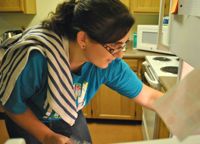
“I found my way back into kitchens,” said Swenson, who worked at a restaurant before coming to PLU. “When I was in high school, I loved the action in the kitchen. I loved the pacing and I loved the smell. It was hard work but you saw what you accomplished. Once I was back in it, it was clear where I was supposed to be.”
After completing his program at Bates Technical College, he went to work for the Sheraton Hotel in Seattle, where he learned about cooking in volume.
From there, Swenson was hired by PLU in 2007, just before the remodel of the University Center.
“Coming in here I got to be part of a team that opened up a completely new restaurant. We were looking at cuisine I never even dreamt of,” Swenson said. “We get the opportunity to make high volume burgers and chickens strips as well as authentic pho and going out to the president’s house to do small plates. You get the chance to do everything from good old American diner food to five-star food.”
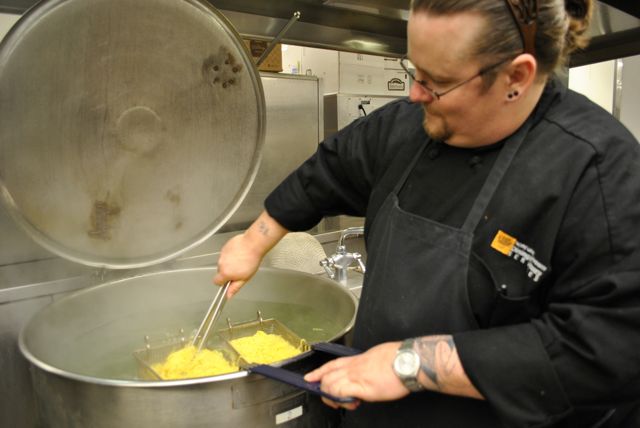
PLU cook Chuck Blessum boils noodles for dinner in the University Commons.
Balancing quality and quantity

‘A microwave is a girl’s best friend – in college at least’
Between classes, working and volunteering Staci Ferin ’13 has little time to cook.
While students are still deep in slumber, Swenson and other morning staffers are prepping for breakfast and lunch. Feeding more than a thousand mouths each day is no easy task – and requires a small army of workers — but they make it look easy.
“I like to think that we’re as interested in our particular topic as an English professor is in theirs,” Swenson said. “We spend our lives researching and looking, watching the food channels, reading magazines, reading books.”
While students are off working, interning and enjoying the summer sun, the Dining staffers are in the kitchen testing out new recipes – it’s a year-round practice, but summer offers a special time for them to really play with food.
“I think one of our favorite things to do is look at street food around the world,” said Erin McGinnis ’90, Director of Dining and Culinary Services.
One of their biggest challenges though is figuring out how to take a small dish and reproduce it for hundreds of people – and if the dish is foreign, there’s the added difficulty of acquiring whatever rare ingredients it calls for.
“You don’t want to lose the integrity of the product in mass producing it,” McGinnis explained.
Some of their ideas simply can’t be adopted because of the high volume the chefs need to produce or because they can’t get a hold of the right ingredients.
But other times they’ll be able to adapt the recipe. Pho – a Vietnamese rice noodle soup – has been one of those items, McGinnis said.
But while introducing new items on the menu, they’re sure to keep and maintain the authenticity of the staples, said Swenson. Meals are served on a four-week rotation, meaning they will appear a set amount of times during a rotation, and some things, like burgers and fries will be offered almost daily.
“Everything that we do here we try to pay really close attention to,” Swenson said.

‘Smart Ones for the smart one’
“I feel like I’m constantly on the go. I wish I had more time and money to cook and have healthier food,” said Ashley Dell’Osa ’13.
Even creating the perfect fry is hard, he said.
“The flavor of that French fry should be crisp and creamy. We need to make sure even the fries, which are just a side dish, can be as good as it can possibly be. To not try to give everyone the perfect fry would be a disservice.”
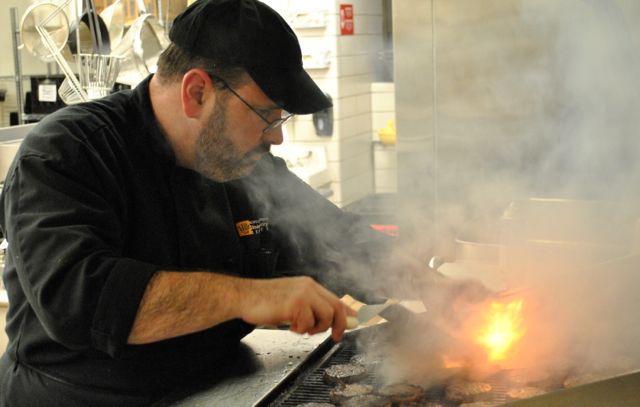
Swenson grills small burgers for a weekend event on campus.
Sourcing local
Most university chefs can’t say with certainty where the meat they cook with comes from — but no one ever said PLU chefs are like most chefs.
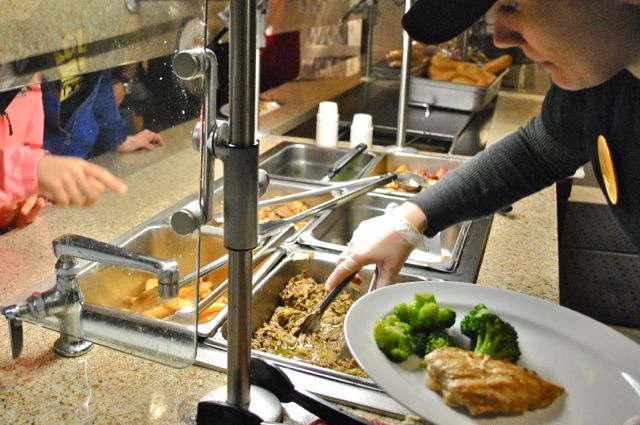
While the rest of the university moves toward the goal of being a carbon neutral by 2020, Dining Services staffers are searching for ways to reduce their own carbon footprint. They work with a number of local companies and farms already, but staffers like McGinnis and Swenson are continually looking for new ways to source locally.
“We try to connect as much as possible with local vendors,” McGinnis said. “We’re still working on those relationships
and how we can be as much farm-to-kitchen as possible. Our biggest challenge is trying to stay local with as much food as we use.”
They’re already utilizing local bakeries, such as Grand Central and Essential Bakery for breads used in the market, and they recently started working with Crown S Ranch, which raises cattle, pigs, sheep, and poultry without toxic drugs or chemicals on organic pastures in Winthrop, Wash.
“I’ve been out to the farm and they have the chickens running around between the sheep, eating what chickens like to eat, and living a life chickens should live,” Swenson said.
Swenson said knowing where the food comes from makes him feel a lot better about serving it.
Dining uses the farm’s whole chicken and recently switched completely over to its loose ground beef.
Swenson is now working on finding a local source for their beef patties, which currently come pre-cooked from Sysco. Using pre-cooked patties has helped ensure they’re serving fully cooked meat, and finding a local farmer that can provide a comparable product has been difficult, Swenson said.
“It’s a lot of sacrifice from a lot of people to get food from

‘Kraft and Betty Crocker ain’t got nothing on my dad’
Dallas Gordon ’14 moved off campus this year and is slowly learning the ropes to cooking.
A student worker serves up a bowl of pasta during dinner in the University Commons.
Foraging for food
While Dining Services staffers cook about 1,800 meals a day, it’s not until many students move off campus or into South Hall that they realize how hard cooking really is. Even those with the most ambitious intentions struggle to find time to cook for themselves.
Some, like applied physics and computer science double major Tim Hurd ’13, who has lived off campus for more than a year, find themselves reinventing the meaning of cooking. Hurd draws his food-spiration from a book his grandma and mom bought him in high school. The book, “A Man, a Can, a Plan,” epitomizes a man’s approach to cooking, with dense laminated cardboard pages and recipes that require a large number of canned and pre-prepared food items – but for Hurd it’s perfect.
“I minimize the time it takes to cook everything, and I usually try to eat while I’m doing something else,” Hurd said.
But “cooking” is a rare occasion for Hurd.
For him, the ideal meal is a Hot-and-Ready pizza from Little Caesars.
“You get one Little Caesars pizza and you have a little bit for lunch, a couple pieces for a snack, and the rest for dinner. All for five dollars,” Hurd said.

‘Quinoa, quin-what?’
Katye Griswold’s ’13 perspective on food drastically changed after reading a diet book written by Rory Freedman and Kim Barnouin during her sophomore year.
On the opposite end of the college food spectrum, is psychology major Katye Griswold ’13, who has also lived off campus for more than a year. She’s arguably one of the more ambitious aspiring chefs among her peers.
“I have a go to meal for like a month and then I change it,” Griswold said. “Sometimes it’s pasta with whatever I have on hand as a sauce, like hummus, or yogurt sauce with pesto. Sometimes it’s quinoa. Sometimes it’s toast. Always lots of spinach and whatever vegetables I accumulate.”
Compared to her fellow college students, she’s a “foodie,” but she hasn’t always been this way.
“I used to make fun of people like me,” Griswold admitted. “I’m pretty much a vegetarian. I cook a lot more. I buy a lot more fresh ingredients. I skip the processed food when I can. I go to farmer’s markets now. I eat quinoa.”
She used to care less about what she ate and where it came from, but that changed when she read a book by Rory Freedman and Kim Barnouin during her sophomore year.
“It was just a book that I happened upon,” Griswold said. “It taught me about our nation’s food system and all the processes that they put the food through. I stopped eating processed food.”
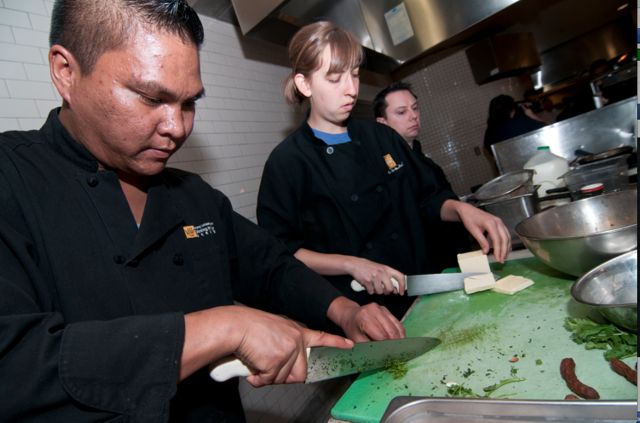
Elizabeth Herzfeldt-Kamprath ’12 works alongside Dining and Culinary staff during the annual Commons on Fire cooking competition.
Cultivating cooks
Stillwell moved into South Hall this fall after living in Tingelstad during her first two years. Like many of the hall’s residents, she didn’t have a meal plan, and although she had a fully equipped kitchen, she didn’t have the tools or skills to use it.
“It’s kind of eye-opening because they’ve never had to cook for themselves,” Stillwell said of her peers. ”I thought that I was going to be doing a bunch more cooking in my apartment. I realized I didn’t have the right pots and pans and utensils or the time.”
Stillwell emailed McGinnis to see if someone from Dining Services could lead a cooking class to help her and her peers.

‘You can never have enough chicken’
As a member of ROTC, Joey Glahn ’12 has lived on campus and enjoyed the benefits of having a meal plan since coming to PLU.
Laura Castano, a swing line cook, worked with Stillwell to plan the menu – lemon grilled chicken, creamy polenta, polenta cakes, salad dressing, and stewed tomato and zucchini, which can be used as a pasta sauce or base for soup.
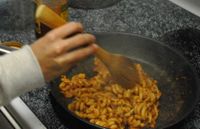
Castano shared the recipes with about a dozen South Hall and Kreidler residents who attended the class in October.
“They don’t have time to cook for themselves,” Stillwell said of her fellow residents, “so we’re trying to find short quick meals that can last for a couple days in the freezer.”
In addition to this class, Dining Services also hosts a number of year-round classes for students, including the Culinary Adventure Series, Culinary Week, and the Commons on Fire culinary competition.



